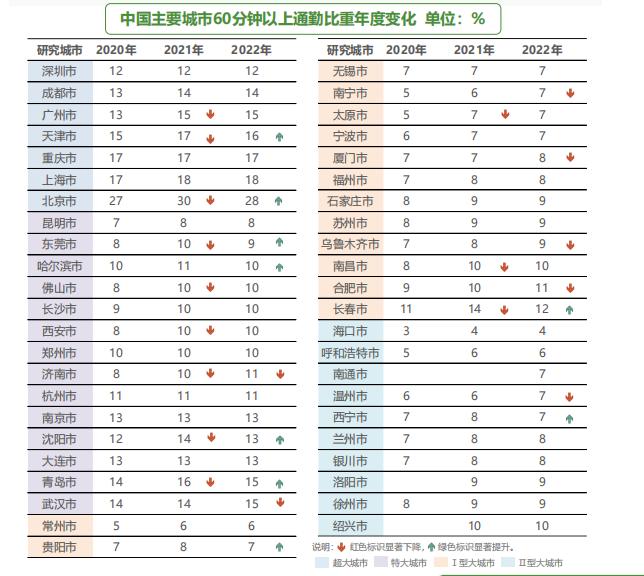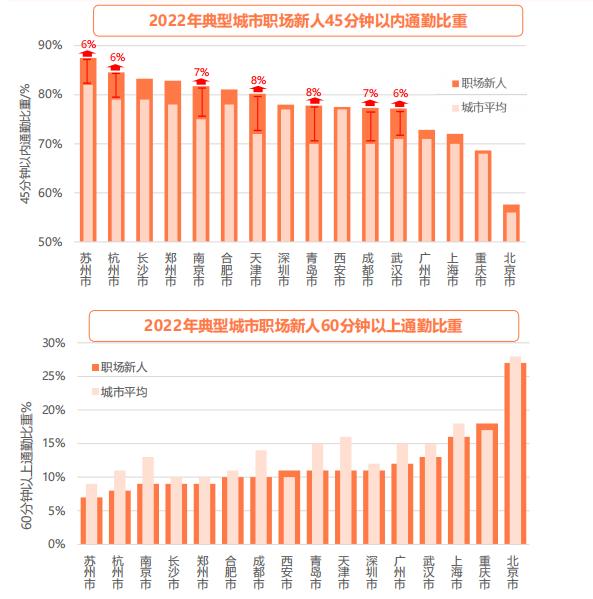There are still over 14 million people in the country suffering from extreme commuting! This type of group has a longer average commuting time, commuting | workplace | group
Introduction: The report shows that among 16 cities, the average commuting distance for new employees in the Beijing Shanghai Chongqing workplace is over 10 kilometers, and 10% of new employees in the workplace have a one-way commuting distance of over 25 kilometers.
Author | Wu Simin from First Financial
Among the eight mega cities with a population of over ten million in China, except for Wuhan, the proportion of "extreme commuting" lasting more than 60 minutes in the other seven cities has not increased in the past year.
On the 18th, the Urban Transportation Infrastructure Monitoring and Governance Laboratory of the Ministry of Housing and Urban Rural Development and the China Urban Planning and Design Research Institute jointly released the "2023 Commuting Monitoring Report on Major Cities in China", which showed the above data.
The report focuses on 45 rail transit cities across the country as monitoring objects, and defines commuting exceeding 60 minutes as extreme commuting to reflect the separation of urban work and residential spaces; Commuting within 5 kilometers is the maximum threshold for "happy commuting", which is used to reflect the proportion of nearby working and living population in the city.
In 2022, the permanent population of Beijing, Shanghai, Guangzhou, and Shenzhen will decrease, and the population gathering capacity of strong provincial capitals in the central and western regions will increase. With the increase and migration of urban population, the improvement of commuting between different cities has also shown differences.
The report shows that commuting in first tier cities has improved within 45 minutes, and the commuting radius remains stable; In second - and third tier cities, the proportion of "happy commuting" in Xi'an, Hangzhou, Hefei, and Nanchang has significantly decreased, and Wuhan, which has only been promoted from a mega city to a mega city, has an extreme commuting ratio of more than 60 minutes, surpassing Shenzhen, a first tier city, and the average commuting distance has exceeded 9 kilometers for the first time.
Compared to the urban average, the average commuting time of newly employed college students is longer, and commuting is more dependent on rail transit. Among the 16 cities with the largest increase in the number of college graduates from 2010 to 2020, Beijing, Shanghai, and Chongqing had a commuting distance of over 10 kilometers for new professionals under the age of 25. More than 40% of new professionals lived within 800 meters of rail stations, and 80% of new professionals had a one-way commuting time of less than 45 minutes.
The proportion of commuting for more than 60 minutes in Beijing has decreased
In the past year, only 50% of the commuting population in 45 rail transit cities across the country has achieved "happy commuting" within 5 kilometers. This indicator has been declining year-on-year for three consecutive years, with over 14 million people still suffering from extreme commuting. However, at the same time, since the reporting and monitoring, for the first time, super cities represented by first tier cities have experienced an overall easing of extreme commuting population.
The report shows that in 2022, the proportion of "commuting within 45 minutes" between Guangzhou and Beijing in first tier cities will increase, while Shanghai will continue to increase. Except for Beijing, 70% of the population in Shanghai, Guangzhou, and Shenzhen have a one-way commuting time of less than 45 minutes. Among them, Shenzhen has reached 77%, maintaining the highest level in first tier cities and approaching 80% of the United Nations human settlement environment construction goals.
The extreme commuting situation of over 60 minutes in first tier cities has also been improved. The report shows that in 2022, the proportion of people commuting for more than 60 minutes in Beijing was 28%, a year-on-year decrease of 2 percentage points, about 200000 people; The proportion of people commuting for more than 60 minutes in Shanghai, Guangzhou, and Shenzhen has not increased for two consecutive years.

The overall commuting time of "migrant workers" in first tier cities in the picture has not continued to increase, which may be related to the stable radiation range of the city and the easing of the degree of separation between work and residence.
According to the report, in 2022, the radius of commuting space in over 7 rail transit cities will increase. Among them, the commuting space radii in Beijing, Shanghai, and Shenzhen all reach 40 kilometers or more, which is the largest range among the 45 cities. However, except for a slight increase in Shanghai compared to the same period last year, the radius of urban commuting space in Beijing, Guangzhou, and Shenzhen did not increase.
According to the three-year report data from 2020 to 2022, the first tier financial reporter further found that the increase in commuting space radius in first tier cities is within 1 kilometer.
The radius of commuting space reflects the spatial range of close commuting connections in a city, and is also the spatial scale that urban transportation needs to support, which to some extent reflects the radiation ability of the city. As the permanent population of first tier cities begins to decrease and the pace of urbanization shifts from "incremental expansion" to "stock renewal", has the average commuting time and distance of the commuting population in first tier cities reached a "peak line"?
One of the authors of the report, Fu Lingfeng, Director of the Data Application and Innovation Center of the Transportation Research Branch of the China Academy of Planning, stated in an interview with First Financial that it remains to be seen whether the phenomenon of reduced commuting time and unchanged space in first tier cities over the past year has a trend characteristic.
On the one hand, factors affecting the COVID-19 epidemic need to be considered; On the other hand, the current increase in the separation of work and residence indicates that the spatial structure of major cities is still undergoing changes and adjustments. In addition, population continues to gather in large cities, which is a law of global urban development. For example, Tokyo is forming an urbanized area with a population of 70-80 million. Looking ahead, the urban agglomeration composed of Beijing and Shanghai still needs to prepare to undertake more population and functions.
"The radius of commuting space is determined by transportation efficiency, and the speed of the subway is only about 30-35 kilometers in radius. With the construction of regional tracks, this radius will also increase to 50-80 kilometers," said Fu Lingfeng.
Statistics show that currently, the scale of Beijing's rail transit has reached 868 kilometers, second only to Shanghai and ranking second in the country. But Fu Lingfeng believes that Beijing's support for urban space, especially commuting, is not as strong as Shenzhen, Shanghai, and Guangzhou. In theory, cities with high rail passenger flow intensity have a rail coverage of over 2000 commuters per kilometer, while Beijing only serves 1700 convenient commuters per kilometer. Although Beijing has other rail functions besides commuting, which can support high passenger flow intensity, the Beijing model may be difficult to replicate.
Fu Lingfeng said that the coverage of the commuter population by the rail determines the potential commuting passenger flow scale of the city. If the passenger flow scale is not ideal, it will ultimately affect the healthy operation of the rail. According to the initial requirements of the National Development and Reform Commission for urban rail construction projects, the overall passenger flow intensity of urban rail should reach a benchmark line of at least 7000 people per kilometer per day. At present, except for first tier cities and six cities in Xi'an and Changsha that meet this standard, Chengdu and Nanning are close to this standard, and nearly 80% of cities have not reached this benchmark level.
The report shows that in 2022, approximately 1000 kilometers of newly operated rail lines will be added nationwide, and the proportion of commuting covered by an 800 meter radius of rail stations will only increase by 2 percentage points. Among them, Zhengzhou and Wuhan have added over 25 kilometers of new routes annually, but the peripheral extension routes have not effectively increased the proportion of commuting coverage.
Correspondingly, Zhengzhou has seen the largest decrease in the proportion of happy commuting and the longest increase in average commuting distance for three consecutive years; As a newly emerging mega city, Wuhan experienced an increase in the proportion of extreme commuting lasting over 60 minutes last year, while the proportion of happy commuting within 5 kilometers of Wuhan has been decreasing for three consecutive years.
The average commuting distance for new professionals under the age of 25 in the Beijing Shanghai Chongqing workplace exceeds 10 kilometers

The commuting big data of the 16 cities with the largest increase in the number of college graduates from 2010 to 2020 defines the commuting population under the age of 25 as new employees in the workplace. Based on this, the report found that in 2022, compared to the average urban commuting population, new professionals in these 16 cities are more likely to live and work nearby. Among 16 cities, 53% of new professionals are able to achieve happy commuting within 5 kilometers, which is 3 percentage points higher than the city average. Among them, in cities such as Suzhou, Changsha, Hangzhou, and Shenzhen, over 55% of new professionals commute within 5 kilometers.
On the other hand, there are also some new professionals who have to bear long-distance commuting due to rental costs and job opportunities. The report shows that among 16 cities, the average commuting distance for new employees in the Beijing Shanghai Chongqing workplace is over 10 kilometers, and 10% of new employees in the workplace have a one-way commuting distance of over 25 kilometers.
Among the newcomers in the workplace in Beijing, 14% of the population needs to bear the long commuting distance. More than 12% of new workplace workers in Tianjin, Xi'an, Zhengzhou, and Chongqing also endure extended commuting, which is 5 percentage points higher than the urban average.
Although the average commuting distance for new employees in the workplace is longer, due to their greater reliance on rail transportation, the proportion of commutes within 45 minutes is higher.
The report shows that 27% of new workplace workers in 16 cities live and work within 800 meters of rail stations, and the proportion of rail coverage commuting is generally 3-5 percentage points higher than the city average; 80% of new professionals can commute within 45 minutes.
However, the closer the rail is, the higher the cost of housing. The report found that the proportion of new professionals living within 800 meters of rail stations in cities such as Beijing, Shanghai, and Guangzhou is difficult to significantly increase. Among them, 27% of new professionals in Beijing commute for more than one hour in one direction, which is the highest among the 16 cities.
According to the latest housing rental index data released by market institutions on July 31st for 40 key cities in China, housing rents in first tier cities such as Beijing and Shenzhen have maintained an upward trend in the past year. In the past three months, housing rents in Beijing, Shanghai, Guangzhou, and Shenzhen have all increased, with Beijing and Guangzhou experiencing increases of 0.62% and 1.14%, respectively. At present, among first tier cities, Beijing's housing rent ranks first, with a median total rent of 6690 yuan/month, followed by Shenzhen, Shanghai, and Guangzhou.
picture




